Julius Caesar s attempts to take over Britain and how he failed
Julius Caesar in Egypt
Chrissy has taught secondary English and history and writes online curriculum. She has an M.S.Ed. in Social Studies Education.
Caesar fought many wars and had many adventures throughout Europe, Africa, and Asia. One of the most fascinating places he traveled to was Egypt. In this lesson, you will learn why Caesar went to Egypt and the events that happened once he got there. Updated: 10/15/2022
Why Was Caesar in Egypt?
How did Caesar wind up in Egypt in the first place? For the first 40 years of Julius Caesar’s life, he actively worked to make a name for himself in Rome. During this time, Caesar avoided capture by Rome’s dictator Sulla, fought a few wars, and was even captured by pirates. But the story of Caesar’s road to Egypt really starts in the year 60 BC.
At the time, Caesar was in a position of power. He was elected a consul of Rome, one of two leaders who ran the Republic like co-presidents. To stay in power and to increase that power, Caesar entered into an agreement with two senators, Crassus and Pompey. Crassus was the man with the money and Pompey was the man with the muscle. The three men controlled Rome with bribes, backdoor political deals, and brute force, and are known by historians as the First Triumvirate.
As consul, Caesar formed a political alliance with the Populare party. He married his third wife, Calpurnia, the daughter of a Populare leader, and married off his own daughter to his political partner, Pompey. At the time, marriage was an incredibly powerful political tool.
While things seemed to be going pretty well for Caesar, he did run into a few issues. He owed a lot of people a lot of money, and more importantly, he owed political favors. Many of the things he did as consul were technically illegal, and evidence against him was growing. To solve his money problems and to increase his influence, Caesar decided to take an army and conquer Gaul, a Roman territory located in present-day France.
Unfortunately for Caesar, things began to change in Rome while he was away. Crassus died, so access to his own private banker came to an end. To make matters worse, his daughter Julia who was married to Pompey died as well. Pompey quickly became the most powerful man in Rome and stripped Caesar of his titles. Pompey demanded Caesar come back to Rome where he would be prosecuted for his crimes.

An error occurred trying to load this video.
Try refreshing the page, or contact customer support.
You must c C reate an account to continue watching
Register to view this lesson
As a member, you’ll also get unlimited access to over 84,000 lessons in math, English, science, history, and more. Plus, get practice tests, quizzes, and personalized coaching to help you succeed.
Get unlimited access to over 84,000 lessons.
Already registered? Log in here for access
Resources created by teachers for teachers
I would definitely recommend Study.com to my colleagues. It’s like a teacher waved a magic wand and did the work for me. I feel like it’s a lifeline.

You’re on a roll. Keep up the good work!
Just checking in. Are you still watching?
Want to watch this again later?
Log in or sign up to add this lesson to a Custom Course.
Getting to Egypt
Caesar had two options: go back to Rome and face the music or fight Pompey. To Caesar, the choice was pretty obvious: the only way to get what he wanted was to kill Pompey and take over Rome. Caesar rallied his troops and prepared to fight Pompey in the area between Gaul and Rome. Pompey was no dummy, though. He knew that Caesar was a formidable general and that he would never stand a chance in a fight. Pompey ran away to Spain before eventually taking off for Greece. It might sound like a nice little European vacation, but in reality, Pompey was headed towards an awful fate. One of Caesar’s smaller armies defeated Pompey in Greece, forcing the Roman ruler to make one final stop in Egypt.
Pompey thought for sure he’d be welcome in Egypt. After all, he had a lot of friends in high places there. In reality, the Egyptians took one look at Pompey, consulted their gods, and determined that the Roman was bad news. Before Caesar could get to Egypt, Pompey was already dead.
Caesar in Egypt
When Caesar heard the news of Pompey’s death, he was outraged. From the outside, it might have looked like he was sad to have lost a friend, but more than likely Caesar looked at Pompey’s death as an excuse to take over Egypt. Caesar moved into the palace and got rid of the Egyptian leader Ptolemy XIII.
At the time, Ptolemy XIII was co-ruling the empire with his sister Cleopatra. Ptolemy and Cleopatra had some serious sibling rivalry, and Ptolemy had actually kicked her out of Egypt. When Cleopatra heard that Caesar was in the palace and had taken over Egypt, she was smuggled into his quarters wrapped up in a rug to avoid detection. Whether Caesar asked her to come, or if Cleopatra had decided to sneak in on her own, is unknown by historians.
Caesar and Cleopatra began a scandalous love affair (remember, Caesar was married to another woman in Rome). Caesar reinstated Cleopatra as the queen of Egypt, and the two of them ruled the empire together. Egyptian leaders were angry with Caesar’s actions. How dare he dispose of their king and take over their country! The Egyptian army laid siege to the palace and kept Caesar and Cleopatra captive for six months. In March of 47 BC, Caesar’s reinforcements arrived, defeated the Egyptian army, and freed the couple from the palace. During that time, Caesar and Cleopatra became very friendly with each other; so friendly, in fact, that they had a son by the end of 47 BC.
While away from Rome, Caesar enjoyed nearly a year of lavish living with Cleopatra, but conflict outside of Egypt forced Caesar to come back to reality. After a small war in Asia, Caesar went back to Rome, this time as a great conqueror. He brought Cleopatra and their son back to Rome with him and gave her a massive palace to stay in. After coming back to Rome, Caesar was made dictator for life and became the most powerful leader in Rome.
Just three short years later, Caesar was assassinated in 44 BC. Cleopatra found another Roman lover, Marc Antony, and the two embarked on their own complicated and tragic affair in the following years.
Lesson Summary
Julius Caesar, Roman consul (one of two leaders who ran the Republic like co-presidents) and eventual dictator, had a very complicated political and personal life. After forming the First Triumvirate with senators Crassus and Pompey, Caesar used his influence to get his way in Roman politics. To make money and gain power, he decided to conquer Gaul. While away, his important political ties to Crassus and Pompey began to fall apart. Pompey took over Rome, and Caesar was forced to either flee or fight him. Caesar chased Pompey all the way to Egypt where Pompey was killed at the hands of the Egyptians. In the year that followed, Caesar took over Egypt, reinstated Cleopatra as its queen, and they co-ruled the empire. Caesar and Cleopatra had a son together, and the three of them returned to Rome.
To unlock this lesson you must be a Study.com Member.
Create your account
Julius Caesar’s attempts to take over Britain and how he failed

In the late summer of 55 BC, Julius Caesar stood on the north coast of France and looked out over the Channel. Some 30 miles across the water lay an island, which, according to travellers’ tales was rich in pearls, lead, gold, and tin. However, Caesar’s interest in Britain was dictated not so much by a desire to exploit her mineral wealth as by the strategic position of the island. He could clearly see that Britain posed a backdoor threat to his latest and greatest conquest (France) whose subjugation Caesar had now enforced after eight years’ hard campaigning. During those years the Celts of Britain had aided their Gallic kinsmen against Caesar and he judged that until Britain was his, the north coast of France would always be vulnerable to a surprise attack.
Caesar, however, was aware that there was little time left before winter brought campaigning to a halt to complete a British invasion, not time enough, in fact, to mount the usual Roman form of attack that called for long-term tactics, infiltrating enemy territory and sapping morale through propaganda and subversion. There was no time either for proper reconnaissance of the island, for gathering information about the nature and size of the country, its harbours and the methods of fighting used by its inhabitants.
Read more
Caesar had already tried to extract this information from the Veneti, a tribe living in Britanny who traded regularly with the British. But the Veneti had refused to talk. Their recent defeat by the Romans had been marked by the massacre of their nobility and the sale into slavery of most of their people, and Caesar’s questions only prompted them to warn the Celts of Britain that Rome’s greatest general was now interested in their land.
Caesar’s reputation in Britain was well known and the Celts knew they would have little chance against the magnificently equipped Roman Army unless their defense was carefully planned. While they armed in secret, they also began to play for time, sending representatives to Caesar at Boulogne ostensibly to offer their submission to Rome. The Celts knew that Caesar would not doubt the sincerity of this; arrogant and accustomed to success as he was, he took this submission as his natural right.
The Celts returned to Britain accompanied by Caesar’s ambassador, Commius, King of the Atrebates, one of the Gallic tribes. With Commius, Caesar sent 30 horsemen, who had instructions to ‘visit as many of the tribes as possible, to persuade them to place themselves under the protection of Rome, and to announce that Caesar himself would shortly be arriving.’
Caesar arrived within a few weeks, on an early autumn morning. He came with 80 transports and the X and VII Legions, but without his cavalry, whose ships had been trapped in France by savage Channel winds. As Caesar approached the White Cliffs of Dover, he found an impressive sight awaiting him. On the clifftops stood rank upon rank of Celts, waiting, Caesar had no doubt, to pay homage to himself and his legions. It was only when the Roman ships came closer to the shore that Caesar saw this was no welcoming party: the British ranks were bristling with weapons.
The Roman galleys sailed northeast towards Deal, and the Celts walked and rode along the clifftops, pacing the ships. It was an unnerving sight for the would-be invaders, and by the time the galleys were as close to the beach as their size would allow, even the courageous X Legion, Caesar’s favourite, was apprehensive. Quite uncharacteristically, these legionaries hesitated for several minutes before obeying the order to jump into the waist-high water. Their hesitation was soon justified. The men were still wading towards the shore, weighed down by their arms and the heavy mailed leather jerkins they wore when the British horsemen came riding out into the surf, swinging their swords and shouting battle cries. Behind the horsemen, on the beach, stood more Britons armed with stones and javelins. Bombarded from above and slipping on the shingle, some of the Romans fell into the water. Enough reached the beach, however, to form up in line and charge their assailants, and with the menacing line of Roman javelins now advancing on them, the Celts turned and fled. It was fortunate for them that Caesar, lacking his cavalry, could order no pursuit.
Read more
The Britons now had tested the strength and determination of the Romans and had found them to be considerable. They decided, therefore, to play for time once again and the following day sent a deputation to Caesar offering apologies for their hostility. With the arrival of the British chieftains who swore loyalty to Caesar, the general once again began to hope that Britain would prove an easy conquest.
The Celtic ceasefire
The Celts’ goodwill, however, was soon seen to vanish when an unexpected but powerful ally came to their aid, the British weather. About a week after Caesar’s arrival, the ships carrying his cavalry appeared on the horizon, almost at once, a fierce storm blew up, tossing the ships about on the water, snapping their masts and tearing their sails to shreds. As the fury of the gale mounted, the ships were driven back towards France, and by the time darkness came, all had disappeared from sight. The bleak dawn that followed revealed a beach littered with the wreckage of Caesar’s transports. All that remained at anchor was a pitiful row of storm-battered hulks.
As the Romans surveyed the appalling scene, the morale of the Celts rose once more. The British chieftains began to slip away from the camp. Peasants were rounded up, war chariots made ready, arms burnished and sharpened. Now that the Romans seemed marooned on their unfriendly island, the Britons were once more preparing to fight them.
The Romans, however, were far from helpless. Roman legionaries were not only superb fighters, but they were also skillful engineers as well, and this would not be the first time they had repaired ships by using the wreckage of those more badly damaged. They were even able to forge the nails that held the timbers together. While the men of the X Legion began this repair work, their colleagues of the VII went foraging for food. From their dense oak forests, the Britons watched the Romans begin to reap their barley fields, waited till the task absorbed them and then rushed out of the trees, yelling war cries and brandishing spears. Some distance away in the Roman camp, sentries saw a huge rising cloud of dust. Immediately Caesar himself and a handful of troops stormed out of the camp and ran towards the fields. At their approach, the Britons fled back into the forest.
The next few days brought more heavy rain, but on this occasion, the weather worked to the Romans’ advantage. It kept the Britons away long enough for them to finish repairing some of their ships and send them to Boulogne to fetch more materials. However, when the downpour at last abated, the Britons staged another lightning raid. The Romans drove them back to their forest hideouts, but by this time Caesar had lost patience with so capricious an enemy, The following evening he packed his troops into the remaining galleys and sailed back to France. He had spent less than three weeks in Britain.
Caesar’s second assault
Caesar did not record his feelings about the failure of his 55 BC invasion, but he was careful to send a report to the Senate in Rome painting a favourable picture of what had, in reality, been a near disaster. As a result, the Senate voted a 20-day period of thanksgiving for Caesar’s ‘exploit.’ To explain its lack of success, Caesar intimated that his expedition had been a mere dress rehearsal for a full-scale assault, planned for the following year. Convinced now that a new ‘province’ would soon be added to the Roman Empire, a motley group of opportunists, treasure-seekers, and adventurers joined Caesar’s second invasion force. This time he took with him five legions (25,000 men) and 2,000 cavalry. He also embarked an elephant–probably the first ever to be seen in Britain.
The Roman fleet of 800 ships arrived off the Kent coast in the summer of 54 BC to find the landing beach deserted. The newcomers, unaware of the events of the previous summer, supposed that the mere sight of the Roman galleys had frightened the Celts away. Caesar knew better. He guessed, correctly, that the Britons had decided to wage guerilla warfare on the Romans, a plan well suited to their inferior weapons and tactics. A pitched battle, which Caesar knew the Britons could not win, was what he now desired most.
Caesar sent scouts to round up a few prisoners, and from them, he learned that the Britons were about ten miles away. It was nearly midnight, but Caesar set off immediately and marched through the moonlit forests and marshes of Kent towards Canterbury. There was a brief skirmish near the banks of the River Stour, but as soon as the Romans began to attack in earnest, the Britons disappeared into the trees. The further the Romans advanced, the further the Britons retreated, drawing the invaders deeper and deeper into the forest.
Guerilla warfare
Once again, the weather came to the Britons’ aid. No sooner had the Romans sighted the British rearguard, than a messenger came running up to Caesar with the news that a gale in the Channel had wrecked his ships, plucking them from their moorings and smashing them down upon the shore. A disappointed and angry Caesar was obliged to abandon the pursuit of his elusive enemy and return to the beach to survey the damage. Forty ships had been completely destroyed. Those less badly damaged were dragged up on the beach and for ten days the Romans worked around the clock to repair them. That done, Caesar ordered his men to dig themselves in behind earthen ramparts and wait for the Britons to attack in force.
The Britons let them wait. They had now overcome petty rivalries in their own camp and had united under one leader, Cassivellaunus, King of the Catuvellauni tribe. He was content now to nibble at the Romans, by sending out raiding parties and staging a few ambushes, knowing that sooner or later, Caesar would have to take the initiative.
Summer was fast fading into autumn when Caesar at last lost patience and marched from his fortified camp towards the Thames. The Romans arrived at the only crossing place to find that the Britons had barricaded it by driving stakes into the riverbed. The obstacle was overcome when the Romans clothed their elephant in armor of iron scales and placed on its back a tower full of archers and slingers. The great beast lumbered into the Thames, with a shower of arrows and stones pouring down from the tower. The terrified Britons bolted for the protection of the trees and refused to come out, except to make a few hit-and-run forays, which did them little good.
Read more
The Four Kings of Kent
Now the unmistakable smell of autumn was in the air and Caesar, aware that time was running out, resorted to subversive tactics. He had in his camp the son of a British chieftain recently defeated by Cassivellaunus. When Caesar promised to restore this young man to his stolen kingdom, some of the smaller tribes deserted their leader. Cassivellaunus, in his growing isolation, persuaded the four kings of Kent to attack Caesar’s base camp and so draw the Romans away to defend it. The plan failed, but Caesar eagerly seized his chance when Cassivellaunus asked for a truce.
Caesar negotiated a treaty imperiously, almost as if he had won a great victory. Cassivelaunus promised to abide by it, but Caesar, impatient now to be gone, took no precautions to ensure that he did so. All Caesar wanted was to get away from this inhospitable island, from its abominable weather, and its cunning inhabitants. Autumn gales were already blowing around the coast and the winds were frothing up dangerously choppy seas when the Roman ships weighed anchor and sailed for France.
Julius Caesar never returned to Britain. The island was left undisturbed for nearly a century until AD 43 when Emperor Claudius ordered the invasion that succeeded where that of Rome’s greatest general had so conspicuously failed.
Explore Julius Caesar’s Rome

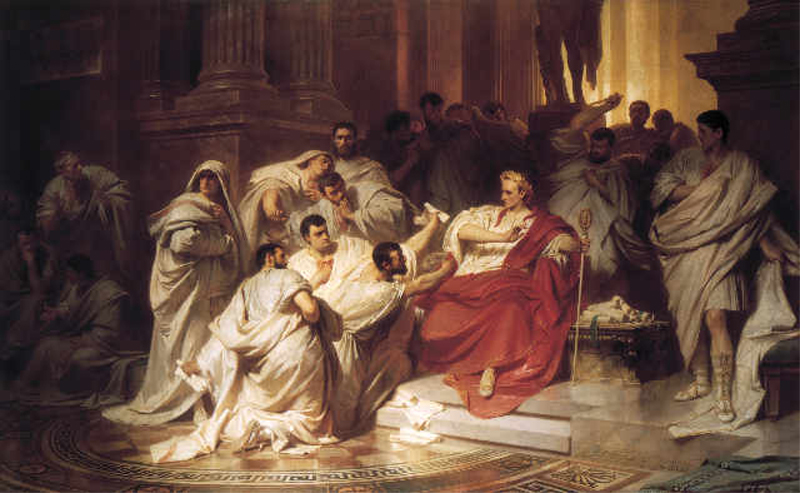
“The Murder of Caesar” by Karl von Piloty, 1865. Wikipedia
Rome doesn’t want for famous residents—from artists to politicians, many notables have called the city home. But, arguably, none changed its course more than Julius Caesar, the shrewd military leader and politician who greatly expanded the Roman Empire and eventually become its self-appointed dictator, paving the way for the imperial system.
To tour Caesar’s Rome requires imagination. Many of the iconic structures that comes to mind when one thinks of Rome—The Coliseum, the Pantheon, the Baths of Caracalla—hadn’t been built when Caesar ruled, and many of the important features of his daily life have long since been buried beneath the growing city. But the archaeological hints that remain transport visitors into the footsteps of one of history’s most heralded and controversial figures.
Julius Caesar was born in Rome, on either the 12 or 13 of July in 100 B.C. Through a combination of political savvy, charisma and backhanded dealings, he quickly rose to power, becoming dictator of Rome in 49 B.C. after emerging victorious from a civil war. As dictator he instituted a number of reforms, from expanding who could be considered a Roman citizen to changing the Roman calendar, but his brief reign came to a bloody end when he was stabbed by a group of Roman senators in Pompey’s Theater on March 15, 44 B.C.
Subura
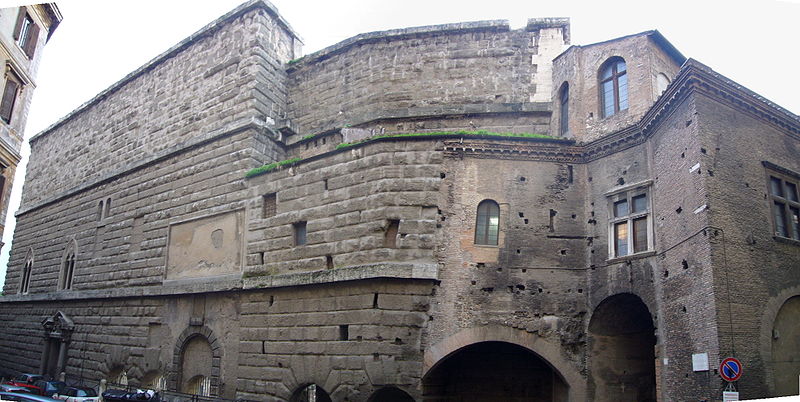
(Wikipedia)
Caesar died the most powerful man in an empire, but he wasn’t always afforded a life of luxury. He was born into an poor noble family in the Roman slums of Subura, and returned to live there as a young man. Monti is the Roman neighborhood which now occupies the area where Subura once stood, located between the Via Cavour and Via Nazionale, east of the Roman Forum. Nowadays, the neighborhood houses intimate eateries, but when Caesar lived there, it was Rome’s red-light district.
Check out the fabulous L’Asino d’Oro, which serves up modern Italian cuisine, or Da Valentino, a classic trattoria.
Via Appia Antica
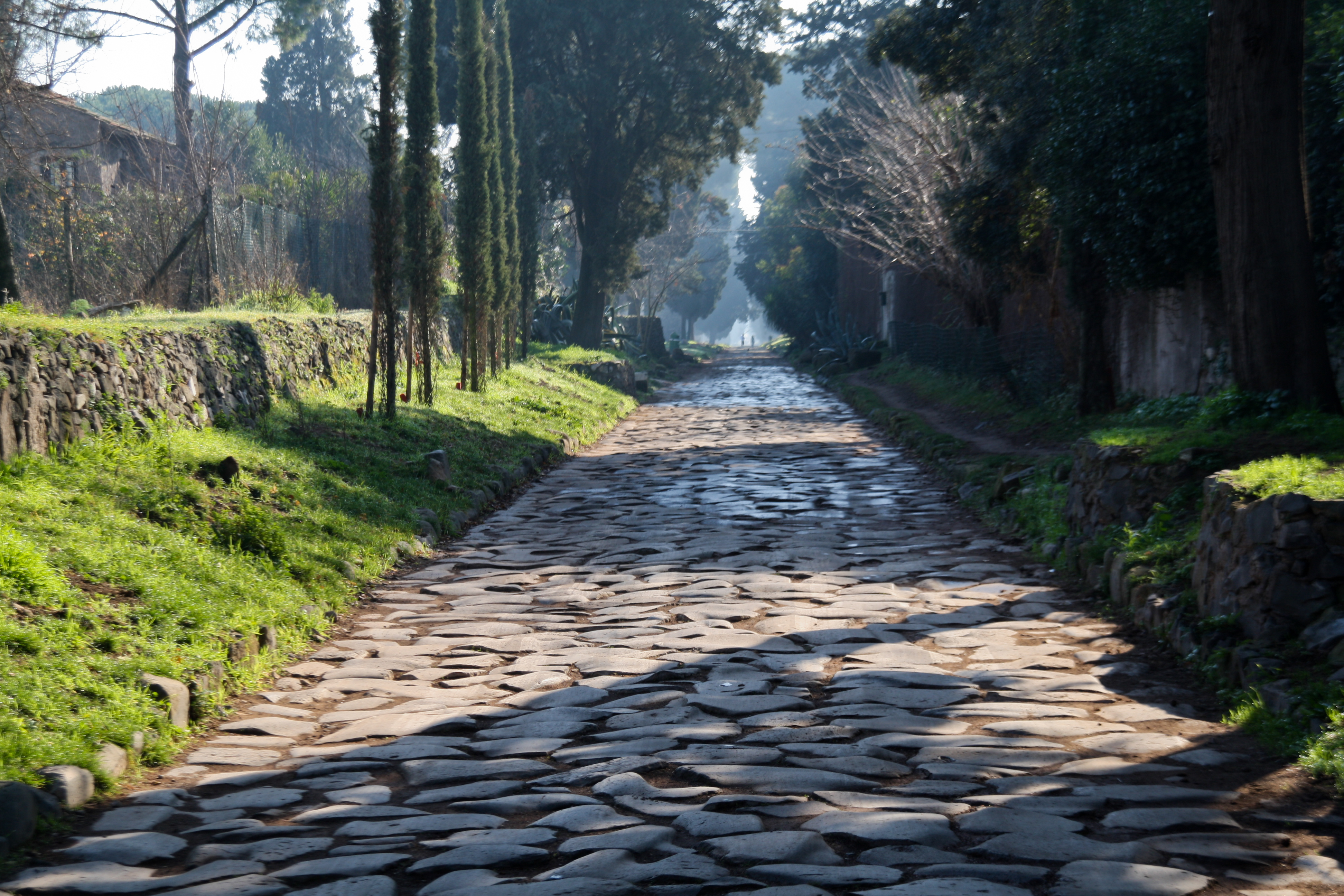
(Flickr user LisArt)
All roads might lead to Rome, but it wasn’t always that way. The Via Appia Antica, the “Queen of Roads,” was built in 312 BC, and by 191 BC, extended all the way to the port of Brindisi, almost 310 miles southeast of Rome on the Adriatic Sea. The Via Appia Antica became Rome’s most important road—and perhaps the most important road in the world—opening Rome up to the East.
By the time Julius Caesar was ascending to power, the road had been worn down. Sensing the importance of the road to Rome and its people, he became the curator of the Appian Way in 66 BC, and borrowed a significant amount of state funds to ensure its restoration. The move gained him political support, which proved crucial in advancing his political career.
To explore the road (and the three catacombs that are open to the public that line it), take the metro out to the Appia Antica stop and head to the Appia Antica Regional Park Information Point. Here, you can buy a map of the park and rent bikes. The park also runs tours, but those must be booked two weeks in advance.
Trastevere
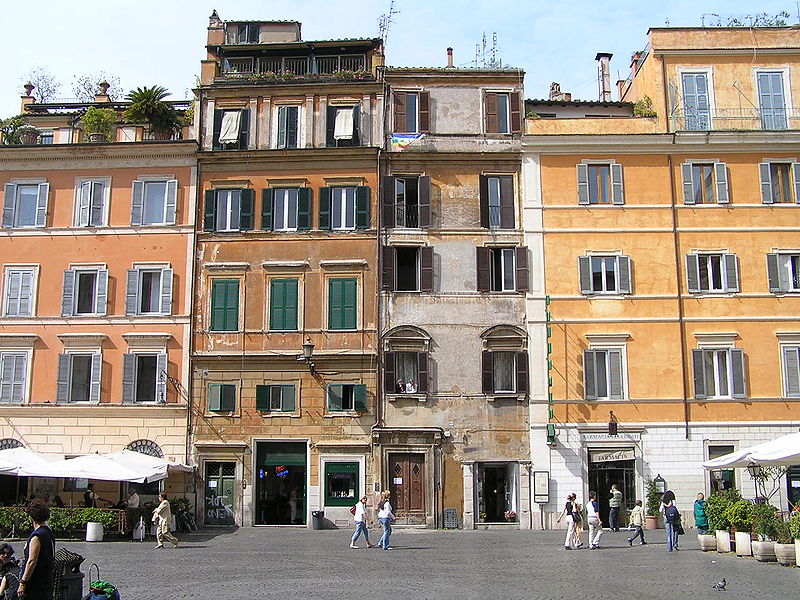
(Wikipedia)
If you think that Trastevere’s charming streets and buildings look downright Medieval, that’s because they are: this neighborhood, located across the river from Rome’s bustling center, is an incredibly well-preserved glimpse into medieval Rome. But it’s got more than Medieval history—it dates back to antiquity, and Julius Caesar once called the neighborhood his second home.
According to historian Stacy Schiff, Caesar’s country estate included a colonnaded court, a mile-long, lushly planted garden, and an extensive collection of paintings and sculptures. Caesar mainly lived in the center of the city, near the Forum, with his third wife, Calpurnia. But it is here in his villa Horti Caesaris, that he is believed to have entertained Cleopatra when she was in Rome in 46 B.C.. Though it’s impossible to pinpoint exactly where the villa once stood, one can gaze across the Tiber toward the center of Rome as the Egyptian queen once did with her son, and Caesar’s love-child, Caesarion.
Wandering the streets of Trastevere transports one back through several periods of Roman history. Visit the 12th-century Basilica di Santa Maria or check out the Villa Farnesina, a Renaissance-era villa with frescoes by artsits like Raphael.
To get to Trastevere, you can either walk from the city center (you can cross the river via the stone footbridge Ponte Sisto) or talk public transportation (tram number 8 to Viale Trastevere).
The Forum
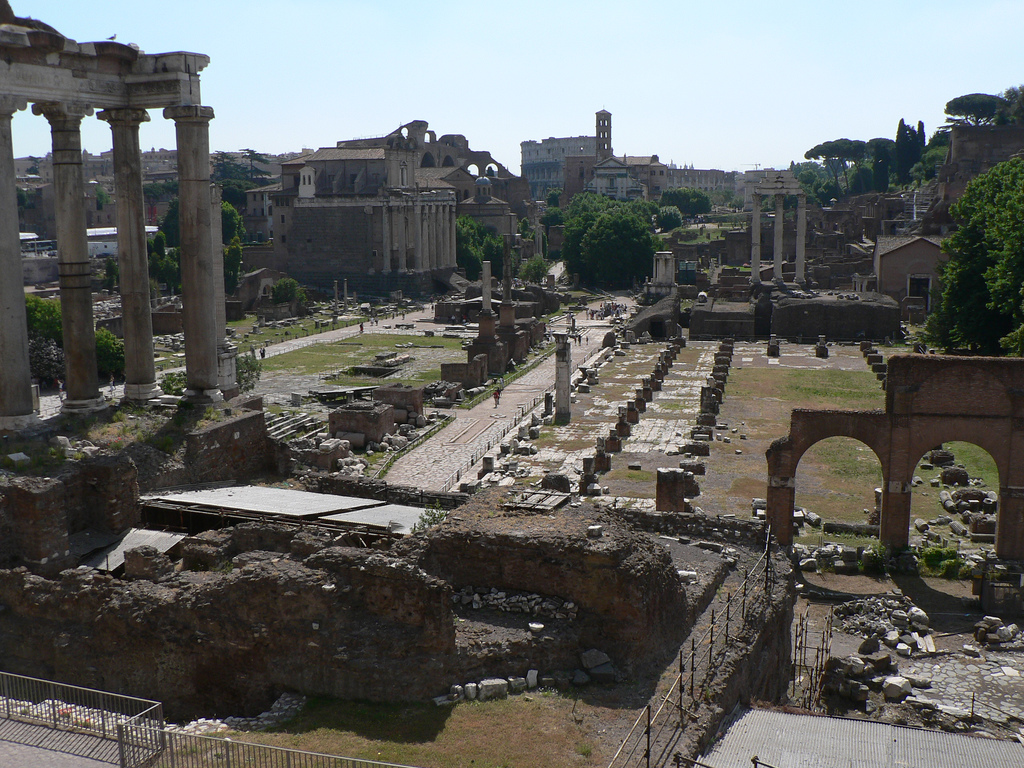
(Basilica Julia. Image via Flickr user John Morris)
Before Rome became one of the ancient world’s most famous Republics, it was ruled by Etruscan kings who built their seat of power in the marshlands between three Roman hills. By constructing a sewer to drain the marshlands, they gained valuable land between the Palatine, Capitoline and Esquiline hills. In 509 BC, when Rome became a Republic, this area became the seat of political power, containing the buildings and temples which were the focal point of Roman political life—an area then, and today, known as the Roman Forum.
Caesar, being an intregal member of Roman political life, would have spent a great deal of his time in and around the Forum. After he rose to power, he even began to change the landscape of the Forum itself by planning and constructing several new buildings and monuments. One such building was the Basilica Julia, the construction of which began in 54 BC. Caesar reorganized the Roman Forum to make way for this massive and ornate basilica, dedicated in his honor, tearing down the Forum’s exisiting basilica (the Basilica Sempronia, built in 169 B.C.). The building was destroyed twice in a fire, once in 8 B.C. and again in 283 A.D. Both times, the basilica was rebuilt, only to be sacked completely during the fall of Rome. The building’s ruins are still visible, however, and the floorplan of the basilica can be easily identified.
You can explore the Roman Forum by purchasing a ticket, which will also grant you access to the neighboring Colosseum and Palatine Hill. Tickets are €12 (about $17). The sites are open from 8:30 a.m. to 7 p.m. Audio tours, as well as guided tours, are offered in a variety of languages. For booking information, call +39 (0)6 39 96 77 00 or go online.
Theater of Marcellus
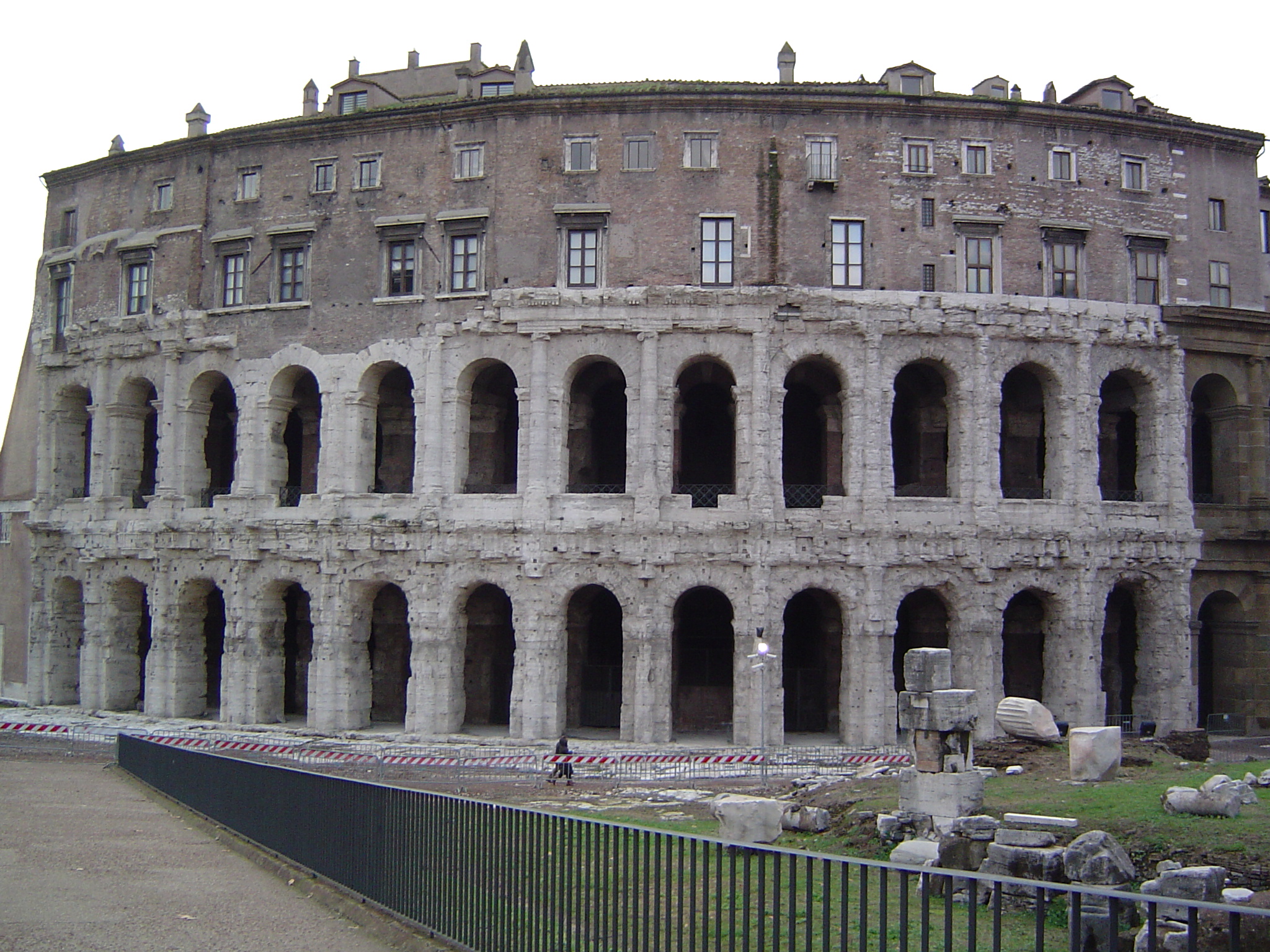
(Wikipedia)
When Caesar defeated his rival, Pompey, in Rome’s civil war, he set out to build a theater that would dwarf the Pompey Theater, which Pompey had built in 55 BC. So Caesar cleared land space for another theater to be built. He never saw the structure completed, however, as he was murdered only a few years into the project. The theater was completed in 13 BC, and it fulfilled Caesar’s hope—it became the largest theater in the Roman Empire. Today, ruins of the theater can be seen on the Via del Teatro di Marcello.
Largo de Torre Argentina
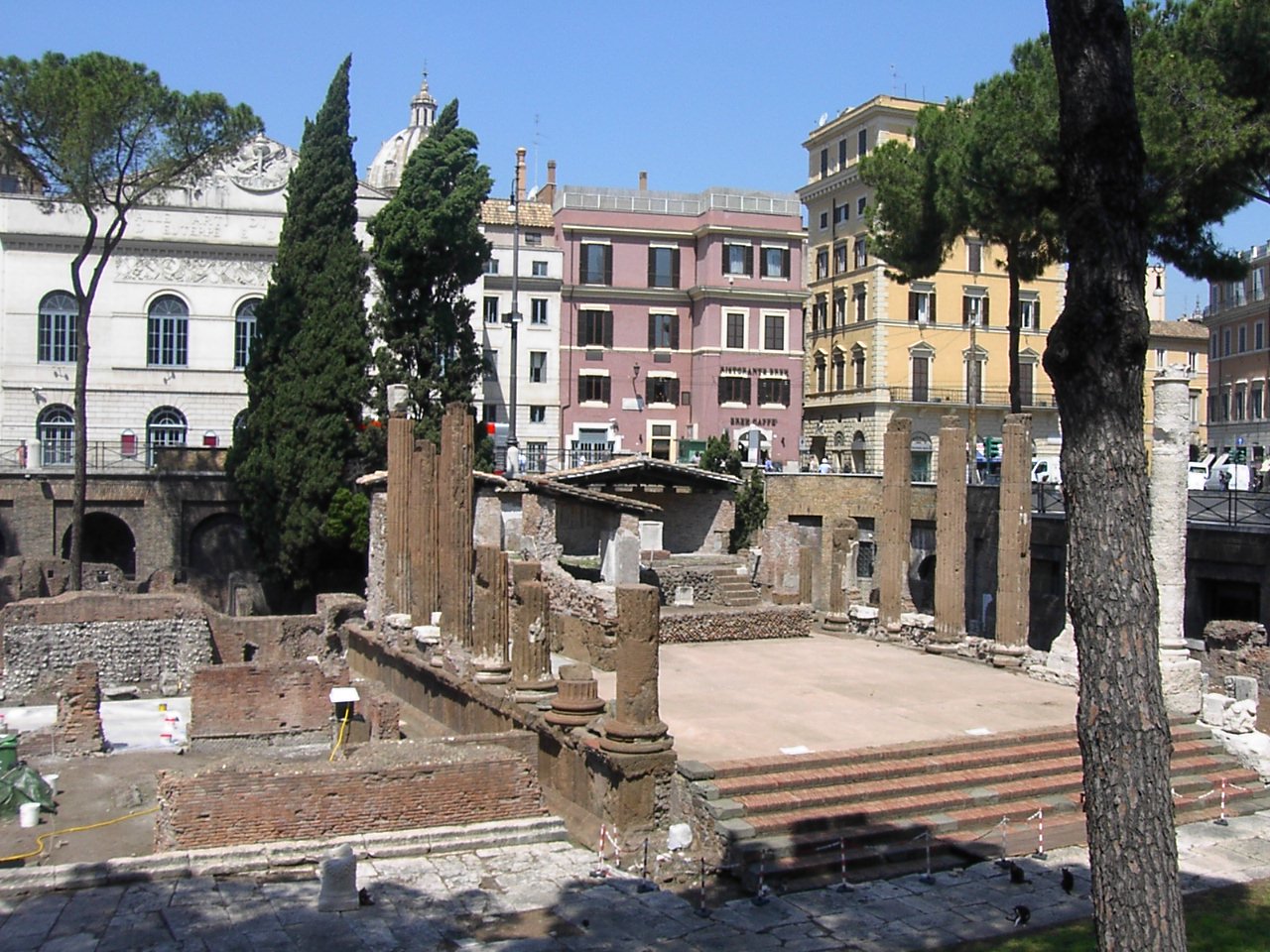
(Wikipedia)
Caesar’s death is nearly as legendary as his life. After defeating Pompey and appointing himself Rome’s dictator, he continued to consolidate his personal power, angering Romans who felt him a threat to the Republic. When, in 44 B.C., Caesar declared himself dictator for life, factions in the Senate turned against him, deciding that the only way to preserve the Republic was to assassinate Caesar.
As legend has it, Caesar ignored several omens that might have helped him avoid his assassination, including a plea from his wife to remain home on the day of his murder. Ignoring these omens, he went to the Senate, where a group of men, including his friend Brutus, waited for him. In Pompey’s Theater, on March 15 44 B.C., the conspirators stabbed Caesar to death.
Pompey’s Theater is long gone (ruins have been incorporated into other structures, making it impossible to truly discern which is which) but the busy square Largo de Torre Argentina stands where the theater once was. It wasn’t until recently, in 2012, that archaeologists found definitive physical proof, in the form of a concrete structure, that Pompey’s Theater did indeed once stand in the square.
To visit the Torre Argentina, head to Rome’s Centro Storico (also home to the Pantheon and Campo de’ Fiori). The physical remains of ruins inside of the square are off-limits, but can be seen from the square’s outskirts.
Source https://study.com/academy/lesson/julius-caesar-in-egypt.html
Source https://britishheritage.com/history/julius-caesar-britain
Source https://www.smithsonianmag.com/travel/explore-julius-caesars-rome-180950262/